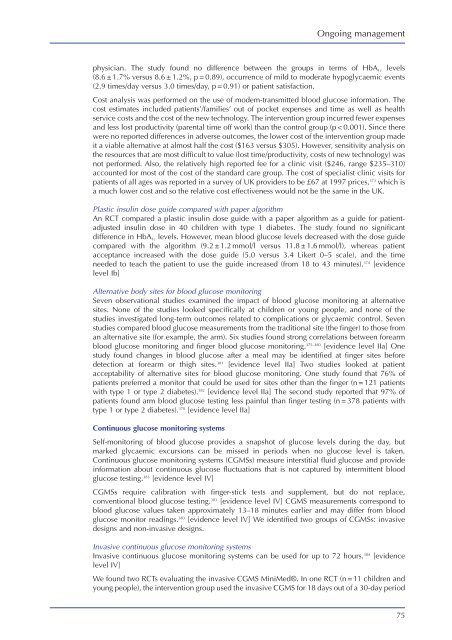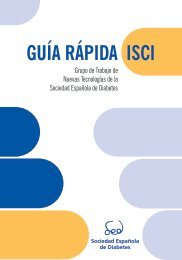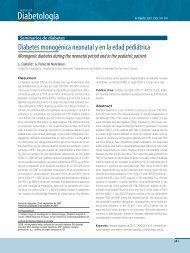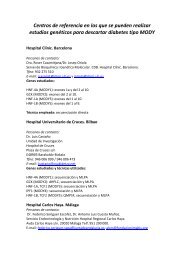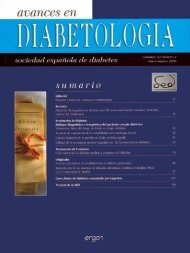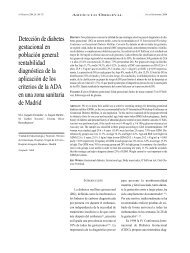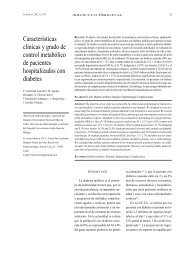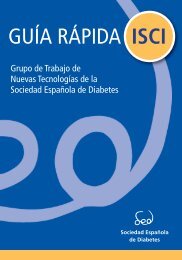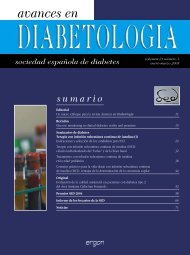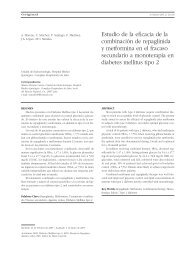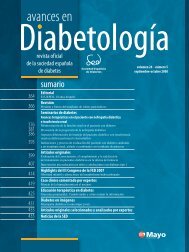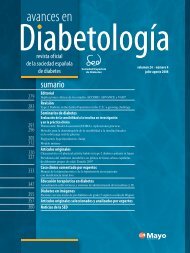Ongoing managementphysician. The study found no difference between the groups in terms of HbA 1c levels(8.6 ± 1.7% versus 8.6 ± 1.2%, p = 0.89), occurrence of mild to moderate hypoglycaemic events(2.9 times/day versus 3.0 times/day, p = 0.91) or patient satisfaction.Cost analysis was performed on the use of modem-transmitted blood glucose information. Thecost estimates included patients’/families’ out of pocket expenses and time as well as healthservice costs and the cost of the new technology. The intervention group incurred fewer expensesand less lost productivity (parental time off work) than the control group (p < 0.001). Since therewere no reported differences in adverse outcomes, the lower cost of the intervention group madeit a viable alternative at almost half the cost ($163 versus $305). However, sensitivity analysis onthe resources that are most difficult to value (lost time/productivity, costs of new technology) wasnot performed. Also, the relatively high reported fee for a clinic visit ($246, range $235–310)accounted for most of the cost of the standard care group. The cost of specialist clinic visits forpatients of all ages was reported in a survey of UK providers to be £67 at 1997 prices, 373 which isa much lower cost and so the relative cost effectiveness would not be the same in the UK.Plastic insulin dose guide compared with paper algorithmAn RCT compared a plastic insulin dose guide with a paper algorithm as a guide for patientadjustedinsulin dose in 40 children with type 1 <strong>diabetes</strong>. The study found no significantdifference in HbA 1c levels. However, mean blood glucose levels decreased with the dose guidecompared with the algorithm (9.2 ± 1.2 mmol/l versus 11.8 ± 1.6 mmol/l), whereas patientacceptance increased with the dose guide (5.0 versus 3.4 Likert 0–5 scale), and the timeneeded to teach the patient to use the guide increased (from 18 to 43 minutes). 374 [evidencelevel Ib]Alternative body sites for blood glucose monitoringSeven observational studies examined the impact of blood glucose monitoring at alternativesites. None of the studies looked specifically at children or young people, and none of thestudies investigated long-term outcomes related to complications or glycaemic control. Sevenstudies compared blood glucose measurements from the traditional site (the finger) to those froman alternative site (for example, the arm). Six studies found strong correlations between forearmblood glucose monitoring and finger blood glucose monitoring. 375–380 [evidence level IIa] Onestudy found changes in blood glucose after a meal may be identified at finger sites beforedetection at forearm or thigh sites. 381 [evidence level IIa] Two studies looked at patientacceptability of alternative sites for blood glucose monitoring. One study found that 76% ofpatients preferred a monitor that could be used for sites other than the finger (n = 121 patientswith type 1 or type 2 <strong>diabetes</strong>). 382 [evidence level IIa] The second study reported that 97% ofpatients found arm blood glucose testing less painful than finger testing (n = 378 patients withtype 1 or type 2 <strong>diabetes</strong>). 378 [evidence level IIa]Continuous glucose monitoring systemsSelf-monitoring of blood glucose provides a snapshot of glucose levels during the day, butmarked glycaemic excursions can be missed in periods when no glucose level is taken.Continuous glucose monitoring systems (CGMSs) measure interstitial fluid glucose and provideinformation about continuous glucose fluctuations that is not captured by intermittent bloodglucose testing. 383 [evidence level IV]CGMSs require calibration with finger-stick tests and supplement, but do not replace,conventional blood glucose testing. 383 [evidence level IV] CGMS measurements correspond toblood glucose values taken approximately 13–18 minutes earlier and may differ from bloodglucose monitor readings. 383 [evidence level IV] We identified two groups of CGMSs: invasivedesigns and non-invasive designs.Invasive continuous glucose monitoring systemsInvasive continuous glucose monitoring systems can be used for up to 72 hours. 384 [evidencelevel IV]We found two RCTs evaluating the invasive CGMS MiniMed®. In one RCT (n = 11 children andyoung people), the intervention group used the invasive CGMS for 18 days out of a 30-day period75
<strong>Type</strong> 1 <strong>diabetes</strong>as well as performing at least four blood glucose tests/day. The intervention group was comparedwith a control group that performed at least four blood glucose tests/day. For both groups, glucosemonitoring results were reported to a member of the <strong>diabetes</strong> clinic staff, and insulin doseadjustments were made over the telephone. More asymptomatic biochemical hypoglycaemicevents were identified in the intervention group (12.8 ± 1.6 versus 6.7 ± 1.1), and these resultedin more changes of insulin dose (11.5 ± 1.5 versus 5.2 ± 0.9). There was no significant differencebetween HbA 1c levels in the two groups after 3 months. The groups showed no significantdifference in fear of hypoglycaemia, or DCCT quality of life. 385 [evidence level Ib] The second RCTinvestigated the use of a CGMS for 3 days every 2 weeks, creating a profile that was used to adjustinsulin therapy at follow-up visits every 6 weeks, compared with patients who used a CGMS for3 days every 2 weeks without making the results available to patients or <strong>diabetes</strong> team with insulintherapy adjustments being made solely on the basis of 7-point blood glucose profiles recorded bythe patients (n = 27, age range 7–19 years). The study found that HbA 1c levels were reduced whenthere was access to the results of the CGMS compared with when there was no access (7.31%versus 7.65%, p = 0.011). 386 [evidence level Ib]We also found 24 studies that evaluated the use of invasive CGMSs compared with bloodglucose monitoring. 387–410 [evidence level IIb] Of these, 18 investigated the same invasive CGMSas the above RCTs, and five investigated other invasive CGMSs. Ten studies showed strongcorrelations between glucose levels measured by invasive CGMSs and conventional bloodglucose monitoring. 387–389,393,396,399,403,404,407,410 [evidence level IIa] Invasive CGMSs detected moreasymptomatic biochemical hypoglycaemia. 392,393,406,408 [evidence level IIa] Short-term use ofinvasive CGMSs combined with information advising patients when and how to change insulinregimen and/or dose was found to reduce HbA 1c compared with baseline in one study inchildren and two studies in adults (child study: reduction at 3 months 0.40 ± 0.94%, reductionat 6 months 0.43 ± 0.87%; 408 first adult study: 8.5 ± 0.9% versus 10.3 ± 0.6%, p < 0.01, n = 10adults; 397 second adult study: 8.5 ± 0.9% versus 10.3 ± 0.6%, p < 0.01, n = 10 adults). 397 [evidencelevel IIa] However, a further study found no change in HbA 1c levels. 393 [evidence level IIa] Fourstudies that evaluated pain and irritation with invasive CGMSs reported that the devices weretolerated with only occasional adverse events. 388,400,403,405 [evidence level IIa] One study reportedstrong reaction to adhesive (2/66 children). 409 [evidence level IIa]Non-invasive blood glucose monitoringSeveral systems for measuring glucose non-invasively through the skin are currently beinginvestigated. These include electrochemical enzyme sensors, transcutaneous near-infraredspectroscopy, 411,412 optical glucose sensors, and infrared spectroscopy. 413Electrochemical enzyme sensors have shown strong correlations between glucose measuredcontinuously and that measured conventionally. However, the device was reported to beuncomfortable, causing redness, itching and tingling. 414–416 [evidence level IIa]One RCT investigated the use of electrochemical enzyme sensors in children and young peoplewith type 1 <strong>diabetes</strong> (n = 40). The study found a reduction in HbA 1c (8.4% versus 9.0%, no SDgiven, p < 0.05), an increase in the frequency of detection of hypoglycaemia (bloodglucose ≤ 70 mg/dl, no values given, p < 0.0003), There was no change in fear of hypoglycaemia(59 ± 14.3 versus 56.4 ± 9.6) or quality of life (81.3 ± 11.7 versus 79.8 ± 15.5). 417 [evidence levelIb] A pilot study conducted as part of this RCT evaluated the cost effectiveness and cost/QALYof standard care versus standard care plus the electrochemical enzyme sensor. The studyreported resource use and costs in the USA and used a simulation model to predict futurelifetime costs and outcomes of children in both groups. Cost effectiveness ratios were reportedas costs/life year and costs/QALY but without description of how the QALY weights werederived. 418 The cost of standard care was $6252/year and the cost of enhanced care with theelectrochemical enzyme sensor was $9127 for the first year and $9017/year thereafter. Thesimulation model showed that enhanced care yielded an additional 0.66 QALYs and thecost/additional QALY was $61,326 (approximately £33,000/QALY). These preliminary results,which were not based on long-term follow up, suggested that enhanced care with theelectrochemical enzyme sensor was an effective but expensive option for monitoring glucose. 41876
- Page 2 and 3:
Type 1 diabetes: diagnosisand manag
- Page 4 and 5:
ContentsGuideline Development Group
- Page 6 and 7:
Guideline DevelopmentGroup membersh
- Page 8 and 9:
Guideline Development Group members
- Page 10 and 11:
Glossary of termsBiasBlinding or ma
- Page 12 and 13:
Glossary of termsCross-sectional st
- Page 14 and 15:
Glossary of termsPowerProspective s
- Page 16:
Glossary of termsSystematic reviewV
- Page 19 and 20:
Type 1 diabetesA separate guideline
- Page 21 and 22:
Type 1 diabetesTable 1.1 Levels of
- Page 23 and 24:
Type 1 diabetesTable 1.3Outcome cat
- Page 25 and 26:
Type 1 diabetesAt the time of diagn
- Page 27 and 28:
Type 1 diabetesChildren and young p
- Page 29 and 30:
Type 1 diabetesChildren and young p
- Page 31 and 32:
Type 1 diabetes• As symptoms impr
- Page 33 and 34:
Type 1 diabetes6.2 Anxiety and depr
- Page 35 and 36:
Type 1 diabetes2.2 Future research
- Page 39 and 40:
3. Diagnosis and initialmanagement3
- Page 41 and 42: Type 1 diabetes• show evidence of
- Page 43 and 44: Type 1 diabetespsychosocial support
- Page 45 and 46: Type 1 diabetesself-monitoring of b
- Page 47 and 48: Type 1 diabetesIndometacinOne RCT h
- Page 49 and 50: Type 1 diabetesdiagnosed type 1 dia
- Page 51 and 52: Type 1 diabetesdiabetes management.
- Page 53 and 54: Type 1 diabetes• advising childre
- Page 55 and 56: Type 1 diabetes• initial and cont
- Page 57 and 58: Type 1 diabetesyears) involved in t
- Page 59 and 60: Type 1 diabetesThe DCCT found no si
- Page 61 and 62: Type 1 diabetesSpecial insulin regi
- Page 63 and 64: Type 1 diabetesHbA 1c was lower aft
- Page 65 and 66: Type 1 diabetesEstablished users of
- Page 67 and 68: Type 1 diabetesTwo rapid-acting hum
- Page 69 and 70: Type 1 diabeteslevels (7.07 ± 0.51
- Page 71 and 72: Type 1 diabetesThree RCTs reported
- Page 73 and 74: Type 1 diabetesinsulin zinc suspens
- Page 75 and 76: Type 1 diabetes4.4 Methods of deliv
- Page 77 and 78: Type 1 diabeteslooked at the absorp
- Page 79 and 80: Type 1 diabetesDisposal of sharpsA
- Page 81 and 82: Type 1 diabetesThere are several ty
- Page 83 and 84: Type 1 diabeteshypoglycaemia: 1.75
- Page 85 and 86: Type 1 diabetesstorage of blood sam
- Page 87 and 88: Type 1 diabetesThree studies in the
- Page 89 and 90: Type 1 diabetesperformed on a month
- Page 91: Type 1 diabetesthat a memory was fi
- Page 95 and 96: Type 1 diabetespackage of care that
- Page 97 and 98: Type 1 diabetesWe found four studie
- Page 99 and 100: Type 1 diabetesChildren and young p
- Page 101 and 102: Type 1 diabetesdiabetes care teams.
- Page 103 and 104: Type 1 diabetesSmokingSmoking has b
- Page 105 and 106: Type 1 diabeteswere hospitalised wi
- Page 107 and 108: Type 1 diabetesWhat is the optimum
- Page 109 and 110: Type 1 diabetesIntranasal glucagon
- Page 111 and 112: Type 1 diabetesadmission for diabet
- Page 113 and 114: Type 1 diabetesContinuous versus in
- Page 115 and 116: Type 1 diabetesSomatostatin therapy
- Page 117 and 118: Type 1 diabetes5.3 SurgeryWe found
- Page 119 and 120: Type 1 diabetesMaintaining hydratio
- Page 121 and 122: Type 1 diabetesdiagnosed at or befo
- Page 123 and 124: Type 1 diabetesA consensus guidelin
- Page 125 and 126: Type 1 diabetespeople with optimal
- Page 127 and 128: Type 1 diabetesIn children under th
- Page 129 and 130: Type 1 diabetesand venlafaxine (sel
- Page 131 and 132: Type 1 diabetesSummaryYoung women w
- Page 133 and 134: Type 1 diabeteschildren and young p
- Page 135 and 136: Type 1 diabetesA theoretical model
- Page 137 and 138: Type 1 diabetesAnother RCT compared
- Page 139 and 140: Type 1 diabetesYoung people with ty
- Page 141 and 142: 7. Continuity of care7.1 Communicat
- Page 143 and 144:
Type 1 diabetesRESEARCH RECOMMENDAT
- Page 145 and 146:
Type 1 diabetesYoung people with ty
- Page 147 and 148:
Type 1 diabetesRecommendation Crite
- Page 150 and 151:
Appendix AType 1 diabetes in childr
- Page 152 and 153:
Appendix ASometimes, it’s possibl
- Page 154 and 155:
Appendix AChildren’s diabetes car
- Page 156 and 157:
Appendix AIf a child or young perso
- Page 158 and 159:
Appendix Aperson who has multiple d
- Page 160 and 161:
Appendix A• Providing they are aw
- Page 162 and 163:
Appendix Aespecially linked to chil
- Page 164 and 165:
Appendix AFor further information a
- Page 166 and 167:
Appendix BClinical evidence forest
- Page 168 and 169:
Appendix BFigure B.3 HbA 1c - studi
- Page 170 and 171:
Appendix BFigure B.5 Hypoglycaemic
- Page 172 and 173:
Appendix BFigure B.7 Patient prefer
- Page 174 and 175:
Appendix CYoung people’s consulta
- Page 176 and 177:
Appendix DManagement of diabetic ke
- Page 178 and 179:
Appendix DA. General:Always accept
- Page 180 and 181:
Appendix D• staffing levels on th
- Page 182 and 183:
Appendix D• If needed, a solution
- Page 184 and 185:
Appendix DAPPENDIX 1Glasgow Coma Sc
- Page 186 and 187:
References1. Smith AHK. The Nationa
- Page 188 and 189:
References59. Satman I, Dinccag N,
- Page 190 and 191:
References2003 [unpublished].121. N
- Page 192 and 193:
Referencesinsulin lispro in continu
- Page 194 and 195:
Referencesin diabetic patients. Ann
- Page 196 and 197:
References301. Kilpatrick ES. Probl
- Page 198 and 199:
References367. Marrero DG, Kronz KK
- Page 200 and 201:
References428. Donaghue KC, Pena MM
- Page 202 and 203:
References496. Edge JA, Ford-Adams
- Page 204 and 205:
References1995;38:607-11.562. Morte
- Page 206 and 207:
References627. Harrison-Woolrych M,
- Page 208 and 209:
Indexacademic achievement 114acarbo
- Page 210 and 211:
Indexdiagnosis 22-4, 134-5algorithm
- Page 212 and 213:
Indexrecommendations 13, 88immunoth
- Page 214 and 215:
Indexneonates (newborn babies) 6, 1
- Page 216:
Indexsuicide 111sulphonylureas 64-5


